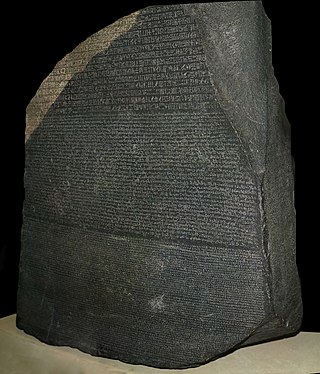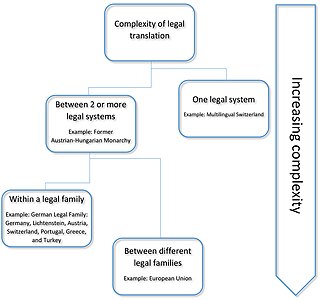Lexicography is the study of lexicons and the art of compiling dictionaries. It is divided into two separate academic disciplines:
Corpus linguistics is an empirical method for the study of language by way of a text corpus. Corpora are balanced, often stratified collections of authentic, "real world", text of speech or writing that aim to represent a given linguistic variety. Today, corpora are generally machine-readable data collections.
An idiom is a phrase or expression that largely or exclusively carries a figurative or non-literal meaning, rather than making any literal sense. Categorized as formulaic language, an idiomatic expression's meaning is different from the literal meanings of each word inside it. Idioms occur frequently in all languages; in English alone there are an estimated twenty-five thousand idiomatic expressions. Some well known idioms in English are spill the beans, it's raining cats and dogs, and break a leg.
Jargon or technical language is the specialized terminology associated with a particular field or area of activity. Jargon is normally employed in a particular communicative context and may not be well understood outside that context. The context is usually a particular occupation, but any ingroup can have jargon. The key characteristic that distinguishes jargon from the rest of a language is its specialized vocabulary, which includes terms and definitions of words that are unique to the context, and terms used in a narrower and more exact sense than when used in colloquial language. This can lead outgroups to misunderstand communication attempts. Jargon is sometimes understood as a form of technical slang and then distinguished from the official terminology used in a particular field of activity.

A loanword is a word at least partly assimilated from one language into another language, through the process of borrowing. Borrowing is a metaphorical term that is well established in the linguistic field despite its acknowledged descriptive flaws: nothing is taken away from the donor language and there is no expectation of returning anything.
Word-sense disambiguation is the process of identifying which sense of a word is meant in a sentence or other segment of context. In human language processing and cognition, it is usually subconscious.

In linguistics, code-switching or language alternation occurs when a speaker alternates between two or more languages, or language varieties, in the context of a single conversation or situation. These alternations are generally intended to influence the relationship between the speakers, for example, suggesting that they may share identities based on similar linguistic histories.

A parallel text is a text placed alongside its translation or translations. Parallel text alignment is the identification of the corresponding sentences in both halves of the parallel text. The Loeb Classical Library and the Clay Sanskrit Library are two examples of dual-language series of texts. Reference Bibles may contain the original languages and a translation, or several translations by themselves, for ease of comparison and study; Origen's Hexapla placed six versions of the Old Testament side by side. A famous example is the Rosetta Stone, whose discovery allowed the Ancient Egyptian language to begin being deciphered.
Hinglish is the macaronic hybrid use of English and the Hindustani language. Its name is a portmanteau of the words Hindi and English. In the context of spoken language, it involves code-switching or translanguaging between these languages whereby they are freely interchanged within a sentence or between sentences.
Language transfer is the application of linguistic features from one language to another by a bilingual or multilingual speaker. Language transfer may occur across both languages in the acquisition of a simultaneous bilingual, from a mature speaker's first language (L1) to a second language (L2) they are acquiring, or from an L2 back to the L1. Language transfer is most commonly discussed in the context of English language learning and teaching, but it can occur in any situation when someone does not have a native-level command of a language, as when translating into a second language. Language transfer is also a common topic in bilingual child language acquisition as it occurs frequently in bilingual children especially when one language is dominant.

Legal translation is the translation of language used in legal settings and for legal purposes. Legal translation may also imply that it is a specific type of translation only used in law, which is not always the case. As law is a culture-dependent subject field, legal translation is not necessarily linguistically transparent. Intransparency in translation can be avoided somewhat by use of Latin legal terminology, where possible, but in non-western languages debates are centered on the origins and precedents of specific terms, such as in the use of particular Chinese characters in Japanese legal discussions.

Levantine Arabic, also called Shami, is an Arabic variety spoken in the Levant, namely in Syria, Jordan, Lebanon, Palestine, Israel and southern Turkey. With over 54 million speakers, Levantine is, alongside Egyptian, one of the two prestige varieties of spoken Arabic comprehensible all over the Arab world.
Language change is the process of alteration in the features of a single language, or of languages in general, across a period of time. It is studied in several subfields of linguistics: historical linguistics, sociolinguistics, and evolutionary linguistics. Traditional theories of historical linguistics identify three main types of change: systematic change in the pronunciation of phonemes, or sound change; borrowing, in which features of a language or dialect are introduced or altered as a result of influence from another language or dialect; and analogical change, in which the shape or grammatical behavior of a word is altered to more closely resemble that of another word.
In linguistics, statistical semantics applies the methods of statistics to the problem of determining the meaning of words or phrases, ideally through unsupervised learning, to a degree of precision at least sufficient for the purpose of information retrieval.

Distributional semantics is a research area that develops and studies theories and methods for quantifying and categorizing semantic similarities between linguistic items based on their distributional properties in large samples of language data. The basic idea of distributional semantics can be summed up in the so-called distributional hypothesis: linguistic items with similar distributions have similar meanings.
Contrastive linguistics is a practice-oriented linguistic approach that seeks to describe the differences and similarities between a pair of languages.

Tatoeba is a free collection of example sentences with translations geared towards foreign language learners. It is available in more than 400 languages. Its name comes from the Japanese phrase tatoeba (例えば), meaning 'for example'. It is written and maintained by a community of volunteers through a model of open collaboration. Individual contributors are known as "Tatoebans". It is run by Association Tatoeba, a French non-profit organization funded through donations.
The Arab sign-language family is a family of sign languages spread across the Arab Middle East. Its extent is not yet known, because only some of the sign languages in the region have been compared.
In natural language processing, a word embedding is a representation of a word. The embedding is used in text analysis. Typically, the representation is a real-valued vector that encodes the meaning of the word in such a way that the words that are closer in the vector space are expected to be similar in meaning. Word embeddings can be obtained using language modeling and feature learning techniques, where words or phrases from the vocabulary are mapped to vectors of real numbers.
Reverso is a French company specialized in AI-based language tools, translation aids, and language services. These include online translation based on neural machine translation (NMT), contextual dictionaries, online bilingual concordances, grammar and spell checking and conjugation tools.







